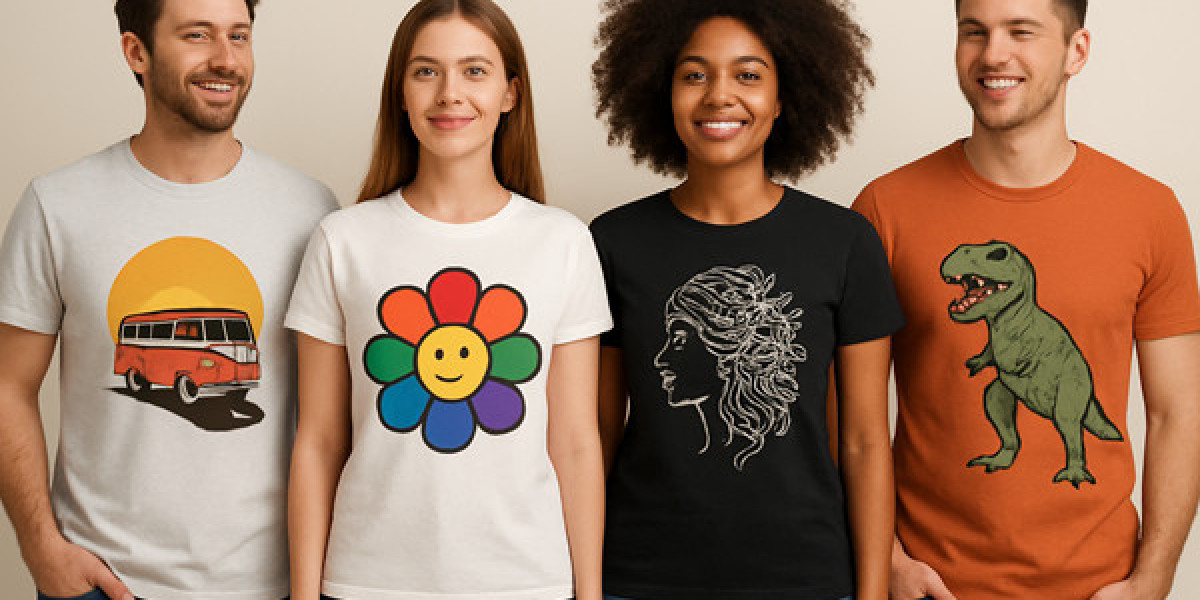T-shirt design has evolved from simple screen-printed graphics to sophisticated digital artworks that capture attention and communicate powerful messages. Whether someone is just starting their journey as a designer or looking to refine their existing skills, understanding fundamental design principles can make the difference between amateur-looking designs and professional-quality artwork that sells.
The world of custom apparel continues to grow, with more designers entering the market every day. Success in this competitive field requires more than just creativity – it demands a solid understanding of design fundamentals that create visually appealing and commercially viable products.
1. Understanding Visual Hierarchy
Creating Focus Points
Visual hierarchy guides the viewer's eye through a design in a deliberate sequence. In t-shirt design, this principle determines which elements viewers notice first, second, and third. Effective designers use size, contrast, and positioning to create clear focal points that communicate the intended message immediately.
The most important element should dominate the design space, while supporting elements provide context without competing for attention. This approach ensures that the main message isn't lost among decorative details or secondary information.
Balancing Multiple Elements
When incorporating multiple design elements, designers must carefully balance their visual weight. Text, graphics, and negative space should work together harmoniously rather than fighting for dominance. This balance creates designs that feel intentional and professional rather than chaotic or accidental.
2. The Power of Typography
Font Selection Strategy
Typography plays a crucial role in t-shirt design success. The right font choice can enhance the message while the wrong selection can undermine even the best concept. Designers should consider readability, personality, and context when selecting typefaces for their projects.
Sans-serif fonts often work well for modern, clean designs, while script fonts can add personality and warmth. However, the key lies in matching the typography to the intended audience and message rather than following trends blindly.
Legibility Across Distances
T-shirt designs must remain readable from various distances and in different lighting conditions. This requirement means avoiding overly complex fonts or text that's too small to read clearly. Testing designs at actual size helps ensure legibility in real-world conditions.
3. Color Theory Mastery
Understanding Color Relationships
Color choices can make or break a t-shirt design. Understanding complementary, analogous, and triadic color schemes helps designers create visually appealing combinations that work well together. These relationships create harmony and prevent designs from appearing amateurish or jarring.
Warm colors tend to advance and grab attention, while cool colors recede and create calm feelings. Designers can use these properties strategically to guide attention and create desired emotional responses.
Considering Fabric Colors
The base color of the t-shirt significantly impacts how printed colors appear. Light designs on dark shirts require different color considerations than dark designs on light fabrics. Experienced designers always consider the final product appearance rather than just how colors look on screen.
4. Composition and Layout
The Rule of Thirds
Applying the rule of thirds to t-shirt design creates more dynamic and visually interesting compositions than centering everything. Placing key elements along these imaginary grid lines or at their intersections often results in more engaging designs that feel naturally balanced.
This principle works particularly well for designs that incorporate both text and graphics, helping designers create layouts that feel intentional and professionally crafted.
Negative Space Utilization
Empty space isn't wasted space – it's a powerful design tool. Effective use of negative space allows designs to breathe and prevents them from feeling cramped or overwhelming. This approach also helps important elements stand out more clearly.
5. Scalability and Adaptability
Vector-Based Design Benefits
Creating designs in vector format ensures they can be scaled to any size without losing quality. This flexibility is essential for t-shirt designs that might be used on various garment sizes or adapted for other products in the future.
Vector artwork also reproduces more cleanly in printing processes, resulting in sharper, more professional-looking final products that customers will appreciate.
Multi-Size Considerations
Designs must work effectively across different t-shirt sizes, from small children's shirts to extra-large adult garments. Elements that look perfect on a medium shirt might become too small or too large when scaled for other sizes, requiring thoughtful planning during the design phase.
6. Target Audience Awareness
Demographics and Preferences
Understanding the intended audience shapes every design decision, from color choices to typography to overall style. A design targeting teenagers will use different visual language than one aimed at business professionals or parents.
Successful designers research their target markets thoroughly, understanding not just demographic information but also cultural references, humor styles, and aesthetic preferences that resonate with specific groups.
Cultural Sensitivity
In today's global marketplace, designs must be culturally appropriate and sensitive. What's humorous or acceptable in one culture might be offensive in another. Thoughtful designers consider these factors to create inclusive designs that appeal to broad audiences.
7. Technical Production Considerations
Print Method Limitations
Different printing techniques have specific requirements and limitations that affect design decisions. Screen printing works best with bold, simple designs using limited colors, while digital printing can handle complex, full-color artwork but might not be cost-effective for large runs.
Understanding these technical aspects helps designers create artwork that not only looks great but also produces well and remains cost-effective for clients or personal projects.
File Preparation Standards
Professional designers deliver print-ready files that meet industry standards. This includes proper resolution, color modes, bleed areas, and file formats. Taking care of these technical details separates professional designers from amateurs and ensures smooth production processes.
8. Brand Consistency and Style
Developing Personal Style
While versatility is valuable, developing a recognizable style helps designers build their reputation and attract consistent clients. This doesn't mean every design looks identical, but rather that a cohesive aesthetic thread runs through the work.
Personal style development takes time and experimentation. Designers often find their voice by exploring various approaches and identifying what resonates most with their creative vision and target market.
Maintaining Quality Standards
Consistency in quality is just as important as stylistic consistency. Every design should meet the same high standards regardless of project size or client budget. This approach builds trust and leads to repeat business and referrals.
9. Market Research and Trends
Staying Current Without Following Blindly
Successful designers stay aware of current trends while maintaining their unique perspective. This balance allows them to create relevant designs that don't immediately look dated. Understanding what's popular helps inform design decisions without dictating them entirely.
Social media platforms, fashion websites, and design blogs provide valuable insights into emerging trends and consumer preferences. However, the key lies in interpreting these trends through one's creative lens rather than copying them directly.
Timing and Seasonality
Many t-shirt designs are seasonal or tied to specific events. Understanding timing helps designers create relevant content that aligns with when customers are most likely to purchase certain types of apparel.
10. Business and Cost Considerations
Designing Within Budget Constraints
Most commercial t-shirt projects have budget limitations that affect design complexity. Smart designers learn to create impactful designs that work within these constraints, using creativity to overcome limitations rather than simply adding expensive elements.
Understanding production costs helps designers make informed decisions about color counts, printing methods, and design complexity while still delivering compelling artwork.
Maximizing Value for Clients
When working with platforms that offer promotional opportunities, designers can help clients save money while maintaining design quality. For instance, timing orders to coincide with special offers or using a Tostadora promo code can significantly reduce project costs, allowing for larger orders or additional design variations within the same budget.
This cost-conscious approach often leads to stronger client relationships and repeat business, as clients appreciate designers who help them maximize their investment.
Conclusion
Mastering these ten design principles creates a solid foundation for t-shirt design success. While creativity and artistic vision remain crucial, understanding these fundamental concepts helps designers create more effective, appealing, and commercially viable designs.
The best designers combine these principles with their unique creative perspective, using technical knowledge to support and enhance their artistic vision rather than constraining it. With practice and application, these principles become second nature, allowing designers to focus on the creative aspects they enjoy most while ensuring professional results.
Continuous learning and adaptation remain essential in this evolving field. As new technologies, printing methods, and consumer preferences emerge, successful designers adapt these fundamental principles to new contexts while maintaining the core standards that create exceptional t-shirt designs.







